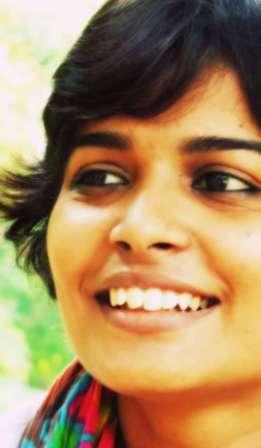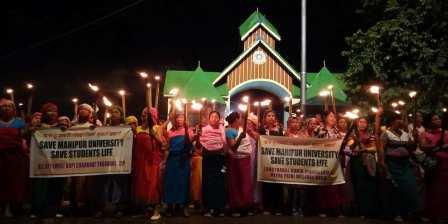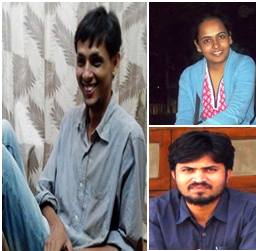Neha
 Whenever an issue of discrimination against marginalized students in higher educational institutions comes in to light, there are always narratives that are projected in mainstream space to deny casteism. Narratives that are thrown towards marginalized communities demanding answers from them rather than institutions taking accountability. Recently majority marginalized students applying for JNU’s PhD program were given single digit marks (out of 30) in their viva voce (Nigam, 2021). One of the narratives that always comes up on this issue is the English vs. Hindi medium student debate. That the reason marginalized students underperform during viva voce is that they lack articulation in English compared to more privileged upper caste students. Noteworthy in this regard is that this is not an isolated incident; discrimination against students from marginalized backgroundsby upper caste professors in viva voce interviews has been happening in the past too. Protests by students’ organizations, and particularly marginalized students’ organizations, have taken place in JNU, DU and HCU earlier too. In general, this is prevalent across higher educational institutions (Deeksha, 2020).
Whenever an issue of discrimination against marginalized students in higher educational institutions comes in to light, there are always narratives that are projected in mainstream space to deny casteism. Narratives that are thrown towards marginalized communities demanding answers from them rather than institutions taking accountability. Recently majority marginalized students applying for JNU’s PhD program were given single digit marks (out of 30) in their viva voce (Nigam, 2021). One of the narratives that always comes up on this issue is the English vs. Hindi medium student debate. That the reason marginalized students underperform during viva voce is that they lack articulation in English compared to more privileged upper caste students. Noteworthy in this regard is that this is not an isolated incident; discrimination against students from marginalized backgroundsby upper caste professors in viva voce interviews has been happening in the past too. Protests by students’ organizations, and particularly marginalized students’ organizations, have taken place in JNU, DU and HCU earlier too. In general, this is prevalent across higher educational institutions (Deeksha, 2020).
This narrative was actually initiated by the academic community as a defense and has strengthened overtime to subdue the voices of dissent that challenge the casteist nature of Academia. Sometimes many marginalized students who try to reflect on this issue also support this narrative. The idea is not to support the casteist claims but to highlight the inequalities present in Indian caste society, thereby our education system and lack of resources available to marginalized communities to sharpen their communication and knowledge skills. But it’s the way this binary further helps the academicians to escape accountability; this is why I think marginalized groups should not indulge in this debate. Emphasis should be given to more and more marginalized students with their anecdotal experience of caste coming to the forefront and sharing it. What goes on inside those interview halls? The questions that are asked in the name of assessing a student’s knowledge on the subject?
The dilemma a marginalized student faces after going through a interview process where he/she was targeted based on his/her social location, is how to process and articulate it. The discrimination is being done under the garb of university as a democratic place. Ahype is created in the name of MERIT because some of the institutions in India and their academic achievements and hold certain influence. Whether they will be believed or not is the first question that comes to a student’s mind. The targeting is subtle. The targeting is also done in such a way that you don’t have tangible evidence. So, when a student narrates it outside, it sounds like fiction. That is how it’s projected by the casteist institutions. Also: as the instance of a student failing to perform and therefore mistaking it as an incident of discrimination. This is such a disturbing aspect for a student’s psyche because you are not only being targeted inside that interview hall but you are also being made to disbelieve what you experienced. On the other hand, more and more narratives gain prominence to suppress students who are not in influential positions. With the way academic institutions enjoy impunity and the caste networks that help them thrive without accountability, an atmosphere should be created by marginalized communities inside and outside the university space both, that encourages students to share their experiences without the fear of being judged. Along with a sustained fight to implement recommendations of committees set up to prevent discrimination against marginalized students (Nagarajan, 2017).
Narratives by university authorities should also not be given prominence as there is negligible representation of marginalized communities in faculty positions too (Ghildhiyal, 2019). What is cited as individual cases of discrimination is actually a systematic exclusion. Language debate also stems from the same mindset that marginalized students are never at par with upper caste students in terms of Merit. Moreover, whenever incidents like these happen there’s always an attempt by the authorities to tone down the critique and concerns of marginalized communities. So, there are limitations to professors being called out. Also marginalized students who are already there in the university even if they are resisting, they are hounded by an atmosphere of uncertainty, their careers being in the hands of these professors. Marginalized students are up against this idea that they don’t belong in an academic space. Their presence destabilizes the status quo. And this is projected in a way that marginalized students are failing to perform rather than the university being invested in maintaining the status quo (Chettri, 2018).
Upper castes love to create binaries in their defense: some students don’t understand the subject matter, whereas others do. Marginalized students always belong to the former group in the evaluation criteria of Indian Academia. One such question arises from the same fact. Recently the DGH (Dismantling Global Hindutva) conference backed by 50 plus universities at a global level was conducted in the US (September 2021). The idea was to counter the rise of BJP/RSS regime which has led to subverting of democratic principles by attacking marginalized communities and institutions in India. Caste was also at the core of this academic conference. Many academicians from renowned universities like JNU and DU were speakers and supporters of this conference: institutions which are always in news in India as reflected through the findings of various committees and students’ protests, of deliberately flouting reservation policies, indulging in casteist practices. The question that arises, what made these intellectuals speak on behalf of the majority oppressed population in India when they have consistently failed to safeguard representation of the same population in their institutions? Is this not a failure to understand the “subject matter”?
Rampant discrimination like this is also not a case of a few departments or centres in educational institutions. This ultimately leads us to the point that there are professors across various departments invested in this through their entire academic careers. (Shobhana, 2016) So why is the aggrieved community made to justify every year what has become a pattern and tactic of upper caste community professors to socially exclude marginalized communities? Why do we never hear professors being called out or their counterparts asking the community to display accountability, demanding they practice fair implementation of constitutional safeguards? The onus is always on the student community to prove and fight while the academic community across various institutions remains silent. What has become a pattern across institutions is always reduced to an incident of a specific institution. The same so-called progressive community however never misses a chance asking marginalized communities to come together and support their leadership, whenever they feel their vested interests, read as ‘academic freedom’ or ‘democracy is under threat’, through various policies of the government at the centre?
When Jotiba Phule wrote ‘Tritiya Ratna’ (1885) which is called as the foundation of not just Marathi theatre but also Indian theatre, the idea was to contexualize caste in a lucid way which is approachable for the masses (Pawade, 2013). By defining education as a Tritiya Ratna, Jotiba was not just talking about attaining education but also the agency that makes one aware about the relation between oppressor and the oppressed. The play in its attempt to stage the social reality of caste was also about educating people on the margins about the power of storytelling outside the framework of upper castes. The play was a counter-attack without a toned down approach asking the oppressed people to figure out their own medium and language in their fight against caste. In this way, it was as much a social movement as about educational pedagogy.
Critical race theory in education in the same context resists the academia dominated by white people and aims to theorize anecdotal experiences of racial discrimination as the central argument in terms of fighting racism in educational institutions. The idea is to provide ground, legitimacy to voices of people of color that might be ignored as personal encounters in order to normalize academia’s discrimination towards people of color.
To quote critical race theory in education in order to theorize the narratives of marginalized communities in Indian Academia:
CRT scholars believe and utilize personal narratives and other stories as valid forms of evidence and thereby challenging a “numbers only” approach to documenting inequality or discrimination which tends to certify discrimination from a quantitative rather than a qualitative perspective (Dixson & Rousseau, 2006, p. 35).
According to Lawrence (as cited in Dixson & Rousseau, 2006, p. 35), “We must learn to trust our own senses, feelings and experiences to give them authority, even (or especially) in the face of dominant accounts of social reality that claim universality”. Thus voice scholarship provides a “counterstory” to counteract or challenge the dominant story (Dixson & Rousseau, 2006).
On the whole, issues like rejecting students in viva voce giving them less marks, even zero, must be seen in the light of how educational spaces invested in various forms of caste-driven practices have forced students to commit suicides. Many of these students are first generation learners from their families, historically excluded from education not because of choice but the way caste functioned in pre-independent India. After independence with the introduction of constitutional safeguards, education was made possible for these disadvantaged groups. On the other hand upper caste professors even after attaining social and cultural capital, sit across these students reducing them to their caste. While students are breaking the shackles of caste, upper caste academics are producing and reproducing it under the façade of modern education. Having done extensive work on caste, from seminars, books to opinion pieces, upper caste academics are thriving here and abroad, while marginalized communities are still fighting for their right to belong in a University space. Caste becomes a business model for these academics when they want to sell it and an excuse for merit when they want to exclude marginalized people. From Rohith Vemula to Dr Payal Tadvi, there are so many brilliant students who were pushed to death because of this. We see many progressive debates in the mainstream related to mental health. It’s time we assert that discrimination like this have serious consequences not just on the individual but also the community that the individual belongs to. And more and more marginalized students should be given the space and support to assert their narratives in order to break free from the narratives normalized by upper castes. Our anecdotal experiences are our theories on Caste.
~
References
Chettri, S. (2018, August 13). MPhil, PhD row: Interviews still on hold as DU waits for clarification from UGC. Retrieved from The Indian Express: https://indianexpress.com/article/education/mphil-phd-row-interviews-still-on-hold-as-du-waits-for-clarification-from-ugc-5303489/
Deeksha, J. (2020, February 20). Did UoH deny admission to marginalised toppers by cutting marks in the interview round? .Retrieved from Edex Live: https://www.edexlive.com/news/2020/feb/20/did-uoh-deny-admission-to-marginalised-toppers-by-cutting-marks-in-the-interview-round-10325.html
Dixson, A. D., & Rousseau, C. K. (Eds.). (2006). Critical Race Theory in Education: All God’s children Got A Song. New York: Routledge.
Ghildhiyal, S. (2019, March 6). SCs and STs account for less than 5% of professors. Retrieved from The Times Of India: https://timesofindia.indiatimes.com/india/scs-and-sts-account-for-less-than-5-of-professors/articleshow/68278545.cms
Nagarajan, K. (2017, January 29). How JNU Flouted Procedure to Revise Admission Criteria, Ignoring and Aggravating Concerns of Caste Discrimination. Retrieved from The caravan: https://caravanmagazine.in/vantage/jnu-admission-caste-discrimination
Nigam. (2021, December 14). JNU discrimination in PhD programmes against SC, ST, OBC, and Muslim students. Retrieved from The second angle: https://thesecondangle.com/jnu-discrimination-in-phd-programmes/
Pawade, S. (2013, April 3). Mahatma Phule – father of Indian social drama. Retrieved from Forward Press: https://www.forwardpress.in/2013/04/mahatma-phule-father-of-indian-social-drama/
Shobhana, N. (2016, December 3). In the name of the Nation: Historicizing Caste in Indian Universities. Retrieved from Round Table India: https://roundtableindia.co.in/index.php?option=com_content&view=article&id=8880:in-the-name-of-the-nation-historicizing-caste-in-indian-universities&catid=119:feature&Itemid=132
~~~
Neha hails from Bihar. She has completed her Masters from Jawaharlal Nehru University, New Delhi. Her areas of interest are casteism in Higher education, Anti-caste Pedagogy, Marginalized women and their agency in Indian society, Intersectionality and critical race theory.










